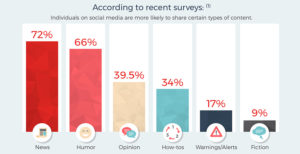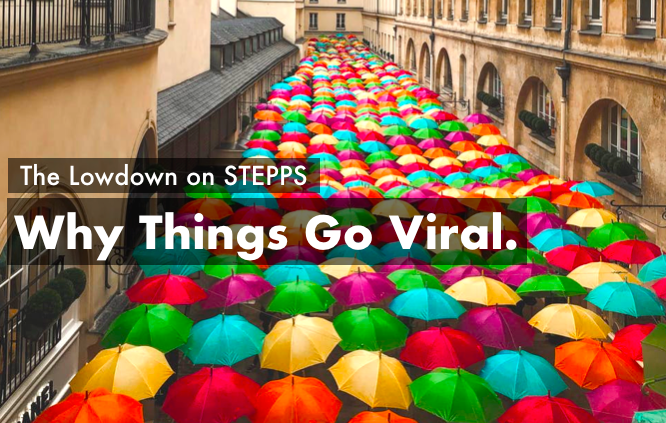Viruses spread fast, the natural types and the computer ones. That’s why we use the term ‘viral’ to mean that content is spreading quickly.
Why Things Go Viral
There are many theories as to why content does or doesn’t go viral, but they all seem to be similar. Simplicity seems to be a common theme, we like a story that we can understand. But, more importantly, we like a story that we can relate to. This is particularly important if it’s something that affects us on a deeper emotional level. If it’s a love story, happy or sad, we feel the tug on our heartstrings. At other times we’re pulled in by sarcasm, snark, and maybe even anger.

All these can be summarized in the acronym STEPPS (Social Currency, Triggers, Emotion, Public, Practical Value, and Stories).
What are the STEPPS to Virality?
- Social Currency – This first ‘S’ is one of the most important factors in the world of social media today. We care about how others see us. Who doesn’t want to look cool, fabulous, or super smart? If your content can make people see a reflection of themselves in it that they believe others will like, you have a chance at going viral.
- Triggers – You want people to think of your content first when anything related to it comes up. Trigger words will pull that memory out. Have you ever had those friends who sing lyrics to certain songs whenever certain phrases are said? For example, you’re discussing education and mention that it’s a whole new world since they started incorporating DQ (digital intelligence quotient) into the system, and your friend starts singing “A Whole New World” from Aladdin. Find your trigger.
- Emotion – You seen those emotional videos that make even the stoniest of hearts shed a tear. It could be a story of love lost or gained, life and death, or even the saving of a puppy or a kitten. When we feel, we tend to share. In other words, sharing is caring. If you can learn more about why videos that are emotional work, you’ll find your content spreading like wildfire.
- Public – This one is pretty obvious, if you share something publicly it has a higher chance of dispersing. When something is made public, it can be easily shared and imitated. Being too private about your content is counterproductive in this sense. Design something that attracts the eyes and allow it to be visible.
- Practical Value – When people find something useful, they share it in the belief that they’re helping others as well (this relates to Social Currency and how we want to be seen). If you make it a point to create content that is useful while still being unique, you’ll find yourself being shared as the expert on that regardless of who tries to copy your content.
- Stories – The second, and final, ‘S’ might be the key to everything. A good story can enchant the entire world. Remember the boys football team that got stuck in that cave in Thailand? It was a story that pulled the entire world together. It comes down to finding a narrative that is incorporates the other 5 parts of STEPPS.

Everyone wants their content to go viral. Try to tailor your content to fit the STEPPS and see if it works. There’s no longer a barrier to creating content or learning how to create good content. Learn as much as you can and give it a shot. Maybe there’s method in this madness of virality, or madness in the method, but you’ll never know until you try.
References
Blakeley, Kiri. “Why Does Something Go Viral?” Forbes, Forbes Magazine, 3 Oct. 2011, https://www.forbes.com/sites/kiriblakeley/2011/09/06/why-does-something-go-viral/#4f2957c84228.
“Jonah Berger: 6 Key STEPPS To Creating Contagious Content.” Unruly, 15 Jan. 2019, https://unruly.co/blog/article/2015/10/26/jonah-berger-6-key-stepps-to-creating-contagious-content/.

